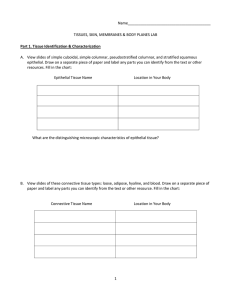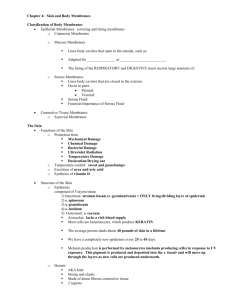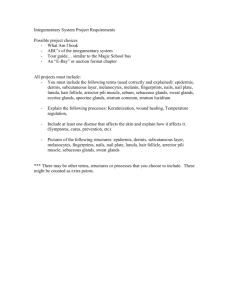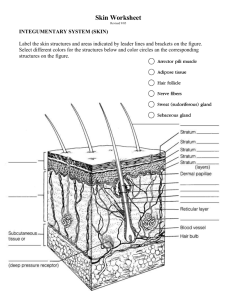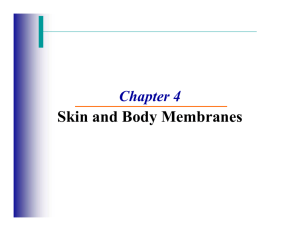Week 03_The Skin & Body Membranes - TAFE-Cert-3
advertisement
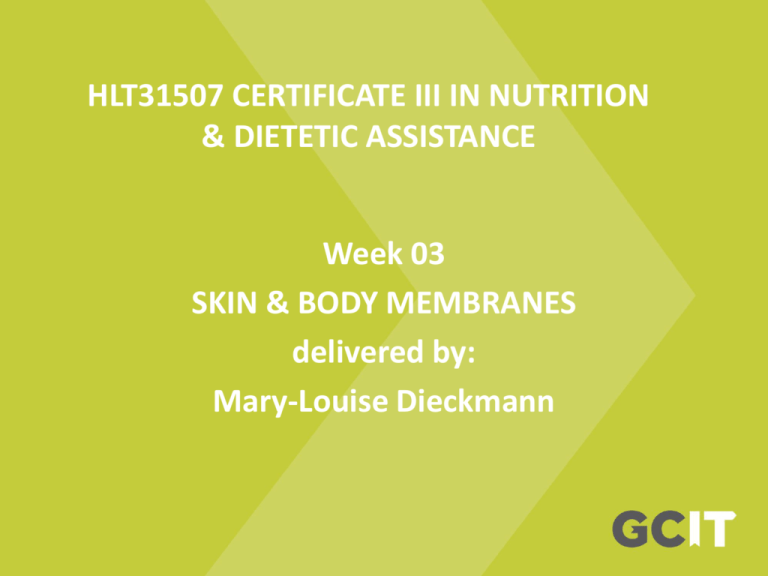
HLT31507 CERTIFICATE III IN NUTRITION & DIETETIC ASSISTANCE Week 03 SKIN & BODY MEMBRANES delivered by: Mary-Louise Dieckmann Body Membranes Functions: • Lining cavities • Protects organs • Covers body surfaces • Lubricates body surfaces Classifications of Body Membranes Two Classifications: • Epithelial Membranes – Cutaneous membrane – Mucous membrane – Serous membrane • Connective Membranes Cutaneous Membrane • Cutaneous membrane = the skin – Dry membrane – Outermost protective boundary • Superficial Epidermis – Keratinized stratified squamous epithelium • Dermis (underneath) – Dense connective tissue Mucous Membranes • Lines all body cavities open to exterior body surface • Adapted for absorption or secretion Serous Membranes Lines body cavities that are closed to the exterior of the body Always occurs in pairs Serous layers separated by serous fluid Connective Membranes • Synovial membranes that cushion or protect their structures • Contain no epithelial cells • Line fibrous capsules – synovial joints, bursae and tendon sheaths The Integumentary System • Skin (cutaneous membrane) • Skin derivatives: – Sweat glands – Oil glands – Hair – Nails Functions of the Skin • Protects deeper tissue from: – Mechanical, chemical, bacterial and thermal damage – Ultraviolet radiation – Desiccation • Aids in heat regulation • Aides in excretion of urea and uric acid • Synthesizes Vitamin D Structure of the Skin • Epidermis – outer layer – Stratified squamous epithelium. Avascular and most cells are keratinocytes – Four or five layers (four mostly, five on palms of hands and soles of feed) • Dermis – underlying layer – Dense connective Tissue • Hypodermis – not part of the skin – Anchors skin to underlying organs, mostly comprised of adipose tissue Epidermis • • • • Stratum basale Stratum spinosum Stratum granulosum Stratum lucidum (only in thick skin) • Stratum corneum Melanin • • • • Pigment produced by melanocytes Yellow, to brown to black Mostly found in stratum basale Amount of melanin produced depends on genetics and exposure to sunlight Dermis Two layers: Papillary layer – Projections known as dermal papillae – Pain receptors – Capillary loops Reticular layer – Blood vessels – Nerve receptors – Glands Skin Structure Colour Determinants • Melanin – Yellow, brown or black pigments • Carotene – Orange-yellow pigment (from vegetables) • Haemoglobin – Red colouring from blood cells in dermis – Oxygen content determines extent of red colouring Skin Derivatives Sebaceous glands: – Produce oil – lubricates the skin and kills bacteria – Most glands have ducts that empty into hair follicles – Glands activated at puberty Skin Derivatives Sweat Glands – Widely distributed across the body – Two types: • Eccrine – open via duct to pore on skin surface • Apocrine – duct empties into hair follicles Sweat • Composition: – Mostly water and some metabolic waste – Fatty acids and proteins in apocrine glands • Function: – Helps dissipate excess heat and excrete waste products – Acidic nature inhibits the growth of bacteria • Odour is from bacteria on skin Homeostatic Imbalances of the Skin • Infections: – Athletes foot (fungal infection) – Boils and carbuncles (bacterial infection) – Cold Sores (virus) – Contact dermatitis (allergic reaction) – Impetigo (bacterial infection) – Psoriasis (cause unknown, can be triggered by trauma, infection or stress) Homeostatic Imbalances of the Skin • Burns – Tissue damage and cell death caused by heat, electricity, chemicals or UV radiation – Associated dangers include: • Dehydration • Electrolyte imbalance • Circulatory shock Homeostatic Imbalances of the Skin Skin Cancer • Two types – benign (encapsulated) and malignant (metastasized) • Most common type of cancer Homeostatic Imbalances of the Skin Basal cell carcinoma (BCC) – Least malignant and most common type – Arises from stratus basale Squamous cell carcinoma (SCC) – Arises from stratum spinosum and metastasizes to lymph nodes – early removal allows good chance of a cure Melanoma – Most deadly of skin cancer – cancer of melanocytes – Metastasizes rapidly to lymph and blood vessels – Detected using ABCD rule Homeostatic Imbalances of the Skin ABCD Rule: A – Asymmetry (two sides of pigmented mole do not match) B – Border irregularity (borders of mole are not smooth) C – Colour (different colours in pigmented area) D – Diameter (sport is larger than 6mm in diameter)

